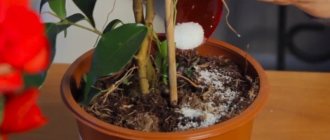Often, violet lovers are faced with the fact that the leaves of the plant begin to shrink. Previously, the violet developed well, but suddenly it began to produce small leaves and lost its former attractiveness.
If this happens to a violet in winter, then the reason is almost certainly a lack of light. Illumination in the autumn-winter period is insufficient for all flowers, and especially for the light-loving violet. Therefore, almost all connoisseurs of this plant use additional lighting in winter - fluorescent lamps.
Shredding of leaves can sometimes occur after replanting. This is a stressful period for the plant; the plant spends energy on adaptation, on rooting, and therefore produces smaller leaves.
The reason your violet has smaller leaves may also be because it is infested with spider mites. It is necessary to carefully examine the plant and, if necessary, take measures to combat the mite.
Also, small leaves can be a sign that the roots of the violet are rotting. You may have filled it up. Remove the plant from the pot and inspect the roots. If there are spoiled roots, cut them down to healthy tissue, sprinkle them with crushed coal and replant them in fresh soil.
There is nothing more beautiful and sweeter than the large, dark green and slightly fluffy leaves of Saintpaulia, framing a small bouquet of bright flower heads on your windowsill. How much they lose their attractiveness if the leaves begin to become smaller over time. This becomes a serious problem, which, if desired, can be solved by analyzing the conditions in which the flower is kept and whether all conditions for caring for it are correctly observed.
Possible reasons
Any flower needs its personal characteristics to be taken into account. Violet is no exception: if you violate the basic requirements for its care, its appearance will suffer first of all. Therefore, in the struggle for the beauty of your pet, you should pay attention to the following points:
- Soil quality. Saintpaulia, like any other indoor plant, loves soil enriched with minerals and nutrients. If you do not change it for a long time, the result may be small leaves. It is best to add humus to the soil and replant every year.
- Lack of space. The roots can grow so large that the flower becomes very cramped in a small pot.
- Excess space. A similar problem will occur if the volume of land is too large. If your beauty is planted in a large pot, its root system simply will not be able to cope with such a scale. The container should be selected taking into account not the leaves, but the size of the roots.
- Low light. Violet loves sunlight (not direct rays), it’s not for nothing that all amateurs and experienced gardeners display it on a lit windowsill. Therefore, if due to circumstances it is in a dark place, provide it with additional lighting, otherwise it will not only change the size of the leaves, but also change color.
- Consequences of transplantation. In this case, Saintpaulia disease is a temporary condition. She is experiencing her stress and will recover very soon.
- Pests. The most common of all is the spider mite, which is invisible at first glance. Therefore, it is necessary to carefully examine each leaf from all sides and urgently take measures to eliminate this pest.
- Excess moisture. Due to excessive watering, the roots of Saintpaulia may rot. You should inspect the root system, cut off the affected matter, sprinkle it with coal and be sure to replant it in new soil.
- Low air humidity. No amount of spraying will help, since they evaporate very quickly and the air becomes dry again. The best option is expanded clay - a specially fired, porous clay that absorbs water well and releases it quite slowly. Flower pots are placed on a pallet into which wet expanded clay filled with water is placed.
general information
There are three main groups of violets:
- collectible;
- industrial;
- variegated.
The majority of the owners of large double inflorescences are the collection species of Saintpaulia , they are quite demanding in care, they require more frequent and active watering, fertilizer, as well as a special light regime.
Most often, such specific species are found at exhibitions or in private collections. The sizes of the inflorescences of collection plants vary from 5 to 7 centimeters. The most popular varieties with large flowering are Lemon Snow, Gift for a Loved One , and some others.
Violet “Gift for a loved one.”
At the same time, small inflorescences are natural for industrial varieties. The rosette of such a plant specimen should not reach more than 15 centimeters. The advantage of industrial varieties is that they are available to everyone, that is, they decorate the window sills of almost every gardener.
Owners can be pleased with small flowering:
- Grote;
- Winter parasol;
- Rococo;
- Avatar, and others.
ATTENTION! Mini-varieties of violets are also easily cultivated at home. With proper care and conditions of their maintenance, Saintpaulias will delight their owners with voluminous foliage and abundant flowering.
The declared sizes of large-flowered violets can reach from 5 to 7 centimeters in volume, while they have soft velvety petals with wavy edges.
These varieties bloom almost all year round , with a break in flowering of no more than 1-2 weeks. In order for a flower to develop safely, it needs:
- diffused light (or partial shade);
- moderate watering;
- fertilizing and fertilizers.
For small-flowered violets, flowers no more than 5 centimeters in volume are natural. Their flowering time is the same as that of large-leaved ones. On average, the flowering period is at least 10 months.
Why do violets have small leaves?
The formation of small leaf plates or grinding of existing ones is mainly associated with :
- Improper care;
- Or inappropriate growing conditions.
Violet leaves become smaller due to improper care.
Any plant requires knowledge of its biological or physiological characteristics and Saintpaulia is no exception . Violating the basic requirements for agricultural technology for growing these delicate but capricious plants, first of all, the appearance suffers, the bulk of which is occupied by green mass.
The fight for the appearance and health of indoor violets does not require much time or money. But, the necessary attention and care must be performed regularly .
Lack of daylight in winter
Light-loving violets can not only change the size of the leaf blades, but also change color due to insufficient light , especially in winter. Even on a lit windowsill during this period there will be insufficient daylight.
Experienced gardeners recommend using additional lighting for plants - phytolamps.
Light is the basis of life not only for violets, but for all plants. The green color of the leaves catches only a certain spectrum of rays , providing the synthesis of organic substances with its energy.
Varieties of indoor violet with dark green, variegated or fairly dense foliage require more daylight hours , and those with light green, wavy or pubescent foliage require less.
Caring for violets
We care for violets correctly!
Usambara violet (Saintpaulia) is a perennial flowering houseplant of the Gesneriaceae family. The birthplace of Saintpaulia is the tropical forests of the Uzambara Mountains.
In order for the African beauty to grow well, it is necessary to create conditions for it “like at home”, that is, provide suitable temperature and soil, proper watering and good lighting, and also do not forget about air humidification and protection from pests. So, in order:
Temperature
Uzambara violets, despite their African origin, do not require greenhouse conditions. The most favorable temperature for them is 18-24°C. Violets cannot stand heat in summer and are afraid of cold drafts in winter. At temperatures above 30 degrees, the flowers become smaller, the borders of multi-colored varieties disappear, and violets may stop blooming altogether. In winter, hypothermia of the earthen clod is dangerous when the violet stands on a cold windowsill. In this case, the roots easily rot and the plant may die.
Soil and fertilizers
The violet is a delicate creature, and it needs “dietary”, non-greasy soil.
Of the ready-made peat soils for violets, the best ones are “Klasmann”, “Agrobalt”, “Greenworld ASB” with the addition of 30-40% baking powder. Perlite or foam balls can be used as loosening agents; they improve the structure of the soil and promote good aeration of the roots.
It must be taken into account that peat soil is poor in nutrients, so violets must be fed with nitrogen-phosphorus-potassium fertilizers. Nitrogen is necessary for leaf growth, phosphorus accelerates root growth and is required for the formation of flower stalks, potassium increases resistance to disease, strengthens the plant, and affects the abundance of flowering.
Fertilizers with a higher proportion of nitrogen (“AGROMASTER 18-18-18”, “Ideal”, “Rostok”, “Uniflor-Rost”) are suitable for young children. For older starters, during the period of bud formation, fertilizing with fertilizers with an increased dose of phosphorus (AGROMASTER 13-40-13, Ethisso) is necessary. From the moment the first flower blooms and for the entire subsequent flowering period, a fertilizer with a high potassium content is required (“AGROMASTER 15-5-30”, “Fertika Lux”, “Uniflor-Bud”).
If violets grow on windowsills, they need to be fed from February to November with a weak fertilizer solution once every two weeks. If Saintpaulias are kept under artificial lighting, then feeding is carried out all year round.
These flowers slowly absorb nutrients, and an excess of fertilizer causes a “reverse effect”: the flowers become smaller, the leaves become fragile and break easily. In order not to “overfeed” the plants, you need to halve the dosage indicated in the instructions or feed them with a very weak fertilizer solution every time you water. It is convenient to prepare a concentrate: 20 g of fertilizer per liter of water. With each watering, add 50 ml of concentrate per 2 liters of water.
Lighting
Light is the most important condition for lush flowering of violets.
They need bright light without direct sunlight (like cloudy days in summer). Violets grow best on eastern and northern windows and bloom continuously from April to November. For winter flowering, artificial lighting is required 12 hours a day. Direct sunlight may cause spots to appear on the leaves. And so that the socket is not one-sided, it must be periodically turned towards the light.
Violets grow very well on shelves with artificial lighting. In this case, they bloom all year round. The source of artificial light can be anything: a table lamp, spotlights or shelves with shelves in several tiers (this is determined by the size of the collection of violets). If violets grow on shelves, a lamp with 1-2 fluorescent or LED lamps should be installed above each shelf. The distance between the shelves is 40-55 cm, so that the distance between the lamps and the edges of the leaves of the rosettes is within 25-35 cm. It is good if one lamp emits “cold” white light (it is needed for the growth of green mass), the second - phytolamp (plant lamp) with the red part of the spectrum. This ensures high-quality flowering of violets with red flowers, allowing you to preserve all the nuances of shades.
Daylight hours for Saintpaulias should be 10-12 hours (to save energy, you can turn on the backlight only for a few hours in the morning and evening, since photosynthesis in violets occurs most intensively in the morning and evening hours). If you equip your shelving lighting system with a timer, the lamps will automatically turn on and off at the right time and create a “cloudy effect” when the lighting is periodically turned off for 15 minutes during the day, which is beneficial for plants.
Different varieties of violets require their own lighting intensity. Violets with dark green, dense leaves are best placed in the center of the shelf; they love bright light, while varieties with light leaves and especially variegated ones are more delicate, they can be placed at the edges of the shelves.
If there is insufficient lighting, violet leaves may stretch upward. In the picture, the violet on the left grew in optimal light, the violet on the right grew in insufficient light.
When there is too much light, the leaves of the plants turn pale and bend down toward the pot, and the rosette itself grows too flat; it can be difficult for flower stalks to break through the dense rows of leaves.
You will need to determine the most suitable shelving or window sill conditions for each specimen by trial and error by moving the plants around.
Watering
If your violets grow poorly, pay attention to watering.
The watering regime should be moderate and uniform. It is necessary to water the edge of the pot with warm water as the top layer of soil dries. The main reason for the death of the plant is rotting of the roots due to waterlogging. There is no need to water obviously damp soil. But the soil should not be allowed to become too dry until the leaves wilt. It is advisable to water the violets with warm water (not room temperature, but warm, approximately like fresh milk). Tap water must be left for at least a day to allow the chlorine to evaporate. Do not allow water to get on the leaves and flowers. For watering, it is convenient to use a small syringe with a long spout.
Between waterings, it is useful to slightly loosen the soil so that it does not cake.
If the leaves of a violet are limp, dull, hanging over the edges of the pot, but the soil is damp, this indicates systematic waterlogging, which results in rotting of the root system. You can try replanting the violet by removing the rotten roots and replacing the soil, or cutting off the top of the rosette with good leaves and re-rooting it.
Air humidity
Saintpaulias are tropical plants and require high air humidity. If the air in the apartment is too dry, the flower stalks in the leaf axils dry out before they have time to develop. It is not recommended to spray violets with water; limescale stains remain on the pubescent leaves, and drops of water damage the flowers. To increase air humidity on top of the pot, you can put a layer of sphagnum moss, place saucers or other containers with water between the violets, or purchase an air humidifier.
If the leaves of your violet are dusty, you can gently wash them under a thin stream of lukewarm water, holding the plant at an angle and covering the ground with plastic wrap so that the water does not erode the soil. After “bathing,” the violet should dry in a warm place without drafts or sunlight, preferably in the bathroom.
Transplantation and propagation
Adult plants are grown in small pots with a diameter of 8-9 cm. A tight pot stimulates flowering - this is the main feature of Saintpaulia. For the violet to bloom, the roots must completely entwine the clod of earth. The recommended ratio of the diameter of the pot and the diameter of the rosette of leaves is 1:3.
As they grow, young violets are transplanted into pots with a diameter of 6-7 cm. An adult violet is annually transplanted into fresh soil in the same pot. When replanting, the plant is removed from the pot, a little soil is removed from all sides, being careful not to damage the roots, and new soil is added. Such a delicate transplant can be done even during flowering.
The optimal time for annual replanting is February, but if necessary, violets can be replanted at any time of the year. If side shoots grow on a violet, they are usually plucked out, as they distract energy and flowering becomes worse. Large stepsons can be carefully separated and rooted. Expanded clay, crushed polystyrene foam, and sphagnum moss can be used as drainage.
Violets are easily propagated from leaf cuttings. The leaf can be rooted in water or immediately planted in the ground, deepening the petiole 0.5-1 cm, and covering the top with a plastic bag. Leaves root very well in Jiffy peat tablets. The tablet is poured with warm water, it increases in height by 3-4 times, maintaining the original diameter. After 5-7 minutes the tablet is ready for use. Excess water must be drained. Then the cutting is placed in the recess in the tablet, lightly compacted and placed in a greenhouse. Roots appear within 3-4 weeks. After 2-3 months, the children that have grown from the leaf are seated.
Pests and diseases of violets
In damp and cold weather, a white coating similar to flour may appear on the leaves of violets. Powdery mildew is a fungal disease. To cure such a violet, it is enough to spray it (and its closest neighbors) with Topaz once.
Of the insect pests, the main enemies of Saintpaulia are thrips and mites. Thrips are small elongated insects that quickly spread throughout the collection. Thrips enter the house in the summer with poplar fluff or with garden flowers. The main alarming symptom is a violation of the integrity of the stamens (pollen spilling onto the petals). All flower stalks should be removed and the collection should be treated with phytoverm - 1 ampoule (4 ml) per 400 ml. water. Treatment is carried out 3 times with an interval of 7 days.
When a violet is infested with mites (microscopic insects), it blooms poorly, the leaves curl and have a dusty appearance. Fitoverm is also used to combat ticks (in a smaller dosage - 2 ml per 1 liter of water).
I wish you success in growing violets!
No flowering when shredding leaf blades
Why does the violet become smaller: many leaves and few flowers? All problems regarding changes in the size of leaf blades to small ones and a delay or lack of flowering are associated with :
- Pests;
- Or a violation of the rules of agricultural technology.
, spider mites lead to such a sad state .
Violet may stop blooming due to violation of maintenance conditions.
Among the mistakes of agricultural cultivation technology it is worth highlighting :
- "Fattening";
- Excessive lighting;
- The pot is too big for the root system;
- Insufficient air humidity (dry air);
- Lack of phosphorus and potassium for nutrition;
- Overwatering;
- Lack of lighting;
- Viral disease - rosette infection;
- Deep landing;
- Ignorance of the variety is a mini-violet.
Comments
There are several reasons for this: Jan Minuet is not an industrial variety, and you probably bought a plant that was donated to a store by some collector and grown in good, benign soil, and also fed with a flowering stimulant. You transplanted it into soil for violets, but no offense be said to its producers, such soils for violets are murder, and it’s a miracle that your plant remained alive and bloomed, in our city for the third year now people have been complaining about these soils, that the plants in them simply burn. But since the violet nevertheless bloomed, it means that the soil turned out to be normal, the reason is completely different: in the summer, the flowers of most varieties of violets become smaller, Jan Minuet is no exception, and besides, after transplantation, the root system has not yet fully adapted to the new soil and pot. And one more thing: You showed a flower in half-bloom, and the flowers of almost all violets grow within a week, so there is no reason to panic.
- Login or register to post comments
Thank you very much! If it’s not difficult for you, please tell me, I read that after 5-6 months the violet needs to be replanted in new soil, after each replantation the flowers during flowering will be smaller or not? Or does it depend on the time of year?
- Login or register to post comments
Nikolay, I usually replant violets 1-2 times a year, most often the size of the flowers depends on the time of year, or rather, dryness and air temperature, the hotter the room. the smaller the flowers, but, again, the same. not for all varieties. After any transplant, violets adapt for about 2 months; if they bloom earlier, the flowers may not be very large.
There are no similar entries.
Ways to solve the problem
Identifying the cause
Identification of the causes of multiple reductions in leaf size should be sought in :
- Violations of growing conditions;
- And mistakes in care.
The loss of appearance, which differs from the characteristics of the variety, always lies in the agricultural technology of cultivation . Let's find out:
- Suitability and quality composition of the soil . If you do not change the soil for a long time, it becomes depleted, it lacks the necessary nutrients and minerals, which can lead to a decrease in the size of the leaves;
If not properly cared for, violet leaves begin to shrink.
Treatment methods
The main and most important method of solving the problem is to study the biological and physiological characteristics of the type of Saintpaulia purchased. Differences in agricultural practices between species can vary significantly.
The second important method, the most effective in combating the crushing of leaf plates, is to find out the cause and resolve it as quickly as possible .
Usually the problem is solved by transplanting into high-quality soil and, no less important, a container carefully selected in size.
If pests are present, treatment must be carried out urgently . If there is insufficient lighting, adjust the required amount of daylight hours. You can do this using:
- Rearranging the flower;
- Or additional lighting.
How to solve a problem?
In order for violets to bloom and delight the owner, it is necessary to properly care for them, create all the necessary conditions, and also eliminate shortcomings in care and development. If the violet flowers have become small, you should pay close attention to this.
Identifying the cause
First of all, violet leaves react to any discrepancy in conditions . They stretch upward if there is not enough light for them, and fall down if there is too much light. They disappear if the flower does not have enough vitamins, or vice versa - they grow with redoubled force and become covered with spots or cobwebs.
It is worth observing the violet leaves very carefully.
In this case, flower growers should be more attentive to their pets and identify the cause of the illness in time. Otherwise, you may lose the flower.
If you become infected with a fungal disease, then by missing the onset of the disease you can lose your entire collection , since the spread of the fungus occurs very quickly.
Adjustment of conditions of detention
As soon as the cause of the green pet’s illness has become clear, it must be eliminated as soon as possible:
- increase air humidity;
- normalize watering and temperature;
- transplant;
- carry out the prevention or treatment of infectious diseases and the like.
Pest treatment
Plants can be treated against pests using preventive methods, the use of biological or chemical preparations, such as Fitoverm, Aktara , and others.
Replanting with complete soil replacement
Transplantation is an emergency method of saving a flower from waterlogging of the soil, rotting of the roots , as well as other parts of the exotic plant. In addition, a transplant can be an excellent annual prevention of infectious and other diseases.
How to preserve a violet if the root system is damaged?
75% of violet diseases are associated with root rot . The result of resuscitation measures depends on the degree of damage. Experienced gardeners can easily revive Saintpaulia with minor to moderate damage. More complex actions, when the stem is completely rotten, it is easier to destroy the violet than to treat it.
Resuscitation consists of removing damaged areas and lower leaves of the plant, with:
- Subsequent treatment with drugs and antiseptics;
- By transplanting into high-quality soil.
Damaged violet roots can be cured by transplanting.
The most dangerous disease for Saintpaulias is rotting of the root collar . Treatment is difficult and dangerous for nearby plants. Few gardeners decide to revive such a plant. Usually it is simply destroyed.











